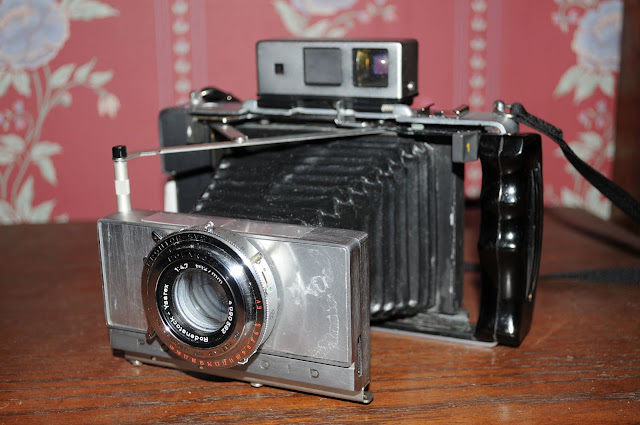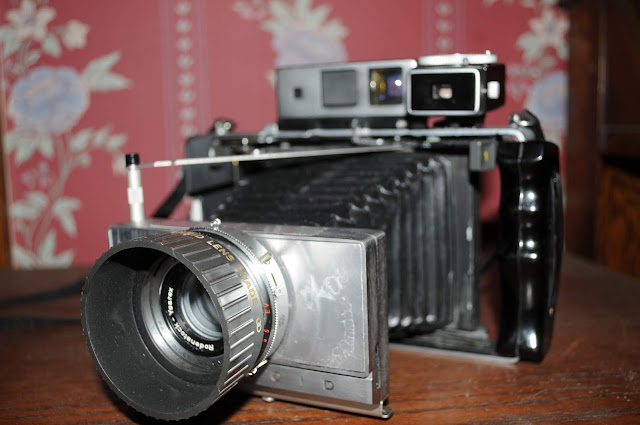This post serves two purposes.
First as a shameless plug for my product, and second as a how-to for
the easiest to use pinhole camera ever!
Pinhole
photography is fantastic. It takes you back to the core elements of
photography- light drawing at it’s most basic. No lens. Just a hole
in a dark box. A shutter is as simple as a piece of tape or cardboard
and shutter speed based on the photographer counting- one one
thousand two one thousand…
The
prior step and the next step are where things have the possibility of
being a bit complicated. First, you need to load the negative or
light-sensitive paper. You will need a completely dark room or a
changing bag. After exposing the shot, you will need the changing bag
again, and you will need to transfer it into a light-tight tank for
processing. Adjusting for the type of film, you will have to take it
through a cycle of the developer, stop, and fix. If you are shooting
color, it can also be pretty challenging to develop the film. Upon
finishing the development, you need to either scan it or develop
prints from the negative in the darkroom.
Now
imagine you can skip all that. All you have to remember is one
one thousand, two one thousand part. This is where instant pinhole
photography comes in. No darkroom, no changing bag, no chemicals.
I
have made a shutter for the Instax Mini. It is attached with two
screws without modification to the exterior of the camera body. The
gate style shutter is just slid along with your fingertips. The
pinhole can be used as I made it or swapped out for a pinhole of your
choice.
If
you choose not to use my shutter, making a shutter yourself is easy!
Just cut out cardboard, thin wood, or plastic to cover the lens area
and drill a hole or use a hole punch in the middle. Lay it aside for
now.
Cut
a nickel or quarter-sized piece of thin metal (you can use thin roof
flashing or thick foil, but I used brass shim metal). Put the metal
on softwood or thick cardboard as a backing and pierce the metal
with a needle. This is a bit easier said than done. It is easier to
handle and drive the needle through the metal if you take a wine cork
and push the needle’s back into it all the way so a half-inch is
sticking out. When you pierce the metal, just pierce with the tip.
You need a tiny hole so it is best to err on the side of caution.
Once you have pierced the metal, it is helpful but not necessary to
sand the hole with 1200 or higher grit sandpaper. If you sand it, go
back and forth and re-round the hole with the needle. The goal is to
have the pierced area as thin as the metal around it.
Tape
the metal to the backside of the cardboard with the pinhole in the
center. Cover the back or front of your cardboard with black
electrical tape or paint it black with acrylic paint. Take a piece of
electric tape and lay it across the pinhole. When you peel up part of
the tape exposing the hole the shutter is open. When you tape it back
down the shutter is closed. This is the simplest pinhole shutter.
Here
is where it can get scary, but don’t be scared. Now you need to gut
your Instax camera. I will start with caution, and if you heed my
warning everything will go fine. This tip applies to any and all
cameras with built-in flashes! The Instax camera will have a large
capacitor. This will dump lots of power all at once. It can zap and
sting you bad, or even kill you if you have a weak heart or heart
related conditions. There are three easy workarounds. The first
one(the one I used for years!) is to avoid touching the leads and
hope you get lucky. Obviously this workaround is not great. The
second workaround is to short out the cap by bridging the two leads
with an insulated screwdriver. This will dump all the energy
instantly, but it will make an alarming pop and spark! The third is to make or buy a capacitor drainer. I bought one on eBay from someone
who makes them. It takes a few minutes to drain, but it is the
easiest of all routes. If this is the only camera you intend to
build, I would go the insulated screwdriver route. It may spook you
for a second, and that isn’t so bad!
Open
the case by removing visible screws. You don’t need to remove the
screws in the battery compartment, but you do need to take off the
battery door. Gently pry the case apart, releasing tiny tabs all
around. Disable and remove the capacitor. Now that you have removed
the danger, just remove everything else! Start with the lens parts,
then the circuit boards. Leave as much wire as possible coming from
the shutter button, the battery, and the motor. Remove all other
electronics. If you are using my shutter, Dremel down the black cone
so there is clearance for the shutter. You will probably only have to
remove 5mm or ¼ inch. If you are not using my shutter, you don’t
have to Dremel anything.
You
are ready for wiring. It is a simple circuit. It goes: battery to
negative line(black) to switch(yellow)out of switch(yellow) to
motor(green) out of motor(blue) to battery(red). I interrupted the
negative side of the circuit with the switch, but you could do it on
the positive side. If you get your wires to the motor backward, it
will just run in reverse. This is just about the simplest circuit
ever, and all you have to do is hold down the momentary switch for it
to engage the motor. You can practice on old film re-loaded into a
cartridge, but you will be comfortable with it within moments or
seconds of use.
Now
mount my shutter with two screws or tape your homemade shutter on. If you choose, you can silver out the flash window with a silver sharpie from the backside or you can leave it like it is. You can also take the original lens front ring and glue it on for looks, or dress it out any way you like! Reassemble the camera with the 7 tiny screws. Use electric tape,
gorilla tape, or any black light-tight tape, and tape from the back
of the shutter to the film opening edge, careful to allow full view
to the film.
You
are now done and ready to shoot. Load your batteries and film and get
to shooting! I count off seconds, but you can use a watch hand or
phone. My shutter can take 2 to 3 seconds in the shade, or less than
a second in bright daylight. Keep in mind that Instax film is very
sensitive(800 iso). In order to keep it simple and fun, write off
your first pack of film to “dialing it in”. This is something
that you can only do with instant film! With standard analog film you
may use the whole first roll bracketing, and develop and print a
contact sheet or scan the film before you know what you have. If you
want to get more complex than the simple and fun experimental way,
you can scan your pinhole and measure it using photo software like
Photoshop, and then put it in a free program like pinhole designer.
There you will get your f-stop and comparable time conversions for a
standard light meter.
There
are a ton of resources. This is just meant to be an introduction to
get you started, but there are many more specific instructions than
this out there. Also, both of these shutters can be added to any
light-tight box to make a camera if Instax doesn’t float your boat!
Happy shooting!
 |
| The white balance in these example shots is pretty bad. The images are not this blue! |


























